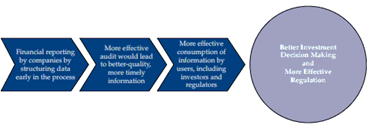In this report, we examine the effects of data and technology on the finance function—the capture/collection of data, their management, analysis, and their use in the production and presentation of financial reports, as well as the audit of those reports. We assess how data, data analytics, and technology may transform the financial reporting process to make it more effective, resulting in greater transparency for investors. Finally, we outline our vision for broader and deeper use of structured data—that is, across all reports in their entirety—to bring about untold efficiencies and transparency for all users.
Summary
Big data and advances in technology have been dominating the discussions of many financial executives in recent years. In fact, the 18th Annual Global CEO Survey from PricewaterhouseCoopers (PwC) highlights the impact of the digital revolution on business, reporting that CEOs are concerned by the speed of technological change.1 The survey states,
But CEOs no longer question the pace of technological change, as they learn to deal with it. The majority of CEOs believe that investments in digital technologies have created value for their business, and around 80% say that mobile technologies and data analytics are key strands of their strategy.
But standard setters appear to be lagging behind the rest of the industry in terms of embracing data and technology in financial reporting. Monga and Chasan illustrate how some think that current disclosure requirements have led to annual reports reaching epic lengths that are difficult for users to consume and lead to added complexity in financial reporting.2
As we note in our paper “Financial Reporting Disclosures: Investor Perspectives on Transparency, Trust, and Volume,”3 ;today’s financial reporting system is based on paper and associates higher word or page counts with increased complexity and neglects the ways that data and technology can improve the quality of information and investors’ access to it. The current system presumes that information is consumed by humans; in other words, it assumes a human consumption model, not a machine-readable format.
Our Approach
We examine the current financial reporting process from end to end and assess the inefficiencies in the system and the ways that data, data analytics, and technology may potentially improve or even transform that process. We also examine financial information consumption by investors, regulators, and other users.
We believe that the use of data and technology can result in a more effective and efficient overall financial reporting process in which investors—including CFA Institute members (primarily analysts and investors)—receive more transparent, better-quality information on a timely basis. As Figure 1 shows, such changes would lead to more effective investment decision making

Our Observations
Companies
Let’s start at the beginning of the financial reporting process with companies. The current manual report assembly and review processes used by companies require both time and money. These processes can be enhanced through the standardization of data, formulas, and presentation of financial information across disparate data sources or software silos and through the effective implementation of disclosure management applications. When data are standardized, these applications are able to pull information from disparate data sources to write automated reports, which enables streamlining of current labor-intensive processes. Such standardization not only saves time and resources for companies but also reduces errors in data because of less manual intervention.4
To achieve these benefits, companies need to structure data early in the reporting process and start thinking of structured data as a form of communication, not merely as a form of delivery.
However, companies continue to view structured reporting as a compliance exercise and cost center rather than as a useful tool. As a result, most companies do not structure their data into a machine-readable format at their source—that is, early in the financial reporting process. Instead, they follow a two-tier process whereby filers prepare their interactive data as an additional step after their financial statements have been prepared simply to fulfill their regulatory filing needs. Consequently, structuring is not producing the intended results (i.e., increasing the speed and frequency with which financial information is prepared, reported, analyzed, and used and reducing the costs).
Auditors and Regulators
Structuring data early in the process would not only benefit companies but would also allow auditors to use audit data analytics to make the audit more efficient and potentially provide users with a better quality and greater granularity of financial information with greater reporting frequency and possibly a higher level of assurance. It also allows regulators to use data analytics to cull structured data from financial reports to identify violations of financial reporting regulations.
Investors
Investors also seek structured quantitative data—combined with management explanation of results in a quantitative and qualitative fashion—which are not bounded by the document in which the information is contained.
With the availability of technology to sift through data and crunch the numbers, investors could be in a better position to perform faster and better analysis. When some of their finite resources are freed up, analysts can not only research more companies but can also take a closer look at the companies they already follow, which would support better-informed investment decisions. Greater efficiency with higher-quality investment decisions is a win for capital markets. Structured data could also bring bigger and better opportunities in small- to mid-cap companies by making it easier and less costly to cover these companies.5
Policymakers
To achieve these changes, regulators need to improve access to and searchability of information within the regulator’s primary source documents. This step would serve to increase the use and the integrity of primary source information. Currently, data providers extract information and provide it in a substantially more useful format than existing regulatory filings, resulting in the greater use of such secondary sources by users. Improvements by regulators could even disintermediate the data providers and thereby truly democratize information.
Structuring data early in the financial reporting process and improving the access to and searchability of information in regulatory filings could produce a virtuous circle. It would help companies by reducing costs and enabling them to analyze the data more quickly and effectively to function more efficiently; it would help investors by allowing them to make more informed investment decisions; and it would bring greater investment to companies that perhaps were not so closely followed by investors previously. All of this would ultimately lead to a more efficient and transparent capital market.
Policymakers’ embracing the disclosure overload narrative without giving consideration to the current technological context has seemed paradoxical to investors who would like to see how technology could be used to challenge this notion and be deployed to improve, rather than reduce, the provision of information.
Recognition by accounting standard setters and policymakers of the changes in technology (i.e., in the connectivity and delivery of data) and the impact such changes have on the perceived quality and relevance of their decisions is essential for the sustainability and relevance of financial reporting and accounting standard setting in the eyes of investors. Investors believe standard setters and policymakers need to integrate into their decisions the effect changes in technology have, or could have, on capturing, managing, analyzing, presenting, and delivering financial data. In sum, because much of the information provided must be mandated by policymakers, they need to incorporate a view regarding technology in their work.
Our Vision
The purpose of this paper is twofold: (1) to argue, on behalf of our membership, for greater efficiencies within the current inefficient system, as we have done previously; and (2) to outline our vision for a future that brings greater transparency to investors. Our vision is for broader and deeper use of structured data.
Structured reporting is most effective when it is applied broadly to all aspects of reporting—that is, to earnings releases and all regulatory filings, such as Form 8-K,6 proxy statements, tax reporting, and so forth.
We believe that, over time, taxonomies could be developed for other forms of reporting, such as integrated reporting, to broaden the use of structured data. Indeed, there have been discussions about introducing eXtensible Business Reporting Language (XBRL)—one form of structuring—to cover corporate actions.
Finally, structuring needs to apply not only to all forms of reporting but also to all companies. There have been discussions in different jurisdictions of smaller entities not using structured data in their filings, which prevents automated analysis of these companies for investors who invest across companies big and small. The availability of financial information in a standardized format also benefits smaller entities looking for greater investment in their companies.
Regulators need to require structured reporting beyond just the financial statements and allow investors a deeper look into annual reports and other reports by applying structuring to all reports in their entirety. For example, in Europe, it has been suggested that only the face of the annual financial statements needs to be structured. However, simply tagging the values on the face of the financial statements is insufficient. It also should be required to separately tag the values in the notes to the financial statements because this information is extremely valuable to investors.
Furthermore, text block tagging should be required for the management commentary, each note to the financial statements, and each significant accounting policy. The user can then perform text analysis using the text block tagged information rather than having to resort to the paper report, increasing ways to use unstructured data.
Such changes would bring greater transparency to users. For example, users would have a better understanding of non-GAAP measures because structuring that information requires the use of formulas. Broader and deeper use of structured data across all reports in their entirety would bring about untold efficiencies and transparency for all users.
